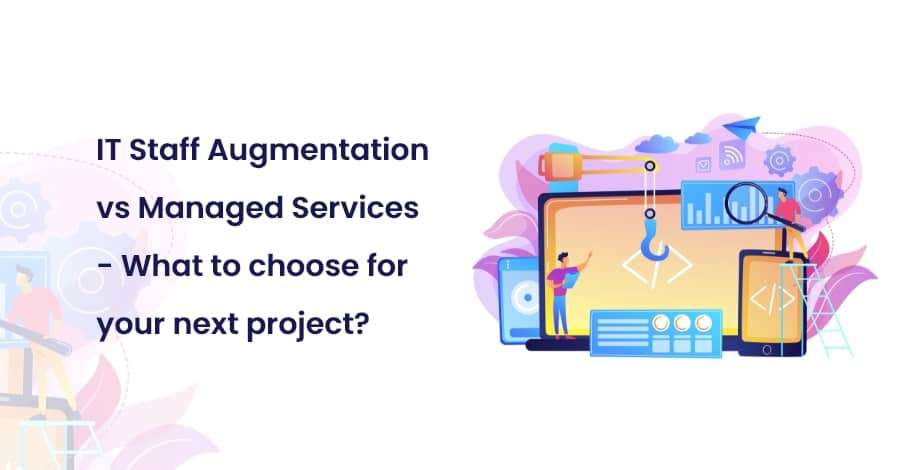
13 Jan Staff Augment. vs Managed: Choose for your next Project?
13 January 2023

The concept of keeping up with the demands of web and mobile app development in the IT industry is crucial. With the rapid advancement of technology and the widespread impact of the Coronavirus pandemic, many companies are in need of immediate assistance, often resorting to familiar outsourcing and outstaffing models.
Staff augmentation vs managed services two popular growth models have gained prominence in this domain. However, they differ significantly from each other. To determine the most suitable outsourcing/outstaffing approach for your needs, it is important to understand the distinctions between managed services and staff augmentation. Given the multitude of business models available, it is normal to have questions or concerns. We aim to clarify these differences and help you make informed decisions for your future projects.
What Is Staff Augmentation?
Staff augmentation is a strategic approach adopted by companies to enhance their workforce capacity swiftly by temporarily hiring external personnel. This flexible outsourcing model allows businesses to access skilled professionals from different locations, including onshore, nearshore, and offshore, and easily adjust the team size according to their specific needs.
Within the realm of IT, staff augmentation proves particularly valuable at various stages of the development process, encompassing tasks like programming, workflow optimization, quality assurance, and quality control. By leveraging this approach, companies can overcome obstacles, fill skill gaps within their teams, adhere to budget and time constraints, resolve issues promptly, and expedite product launches.
Staff augmentation offers a cost-effective solution, granting businesses the advantage of flexibility. It serves as a temporary measure that optimizes existing resources and personnel while harnessing the expertise of external professionals, ultimately reducing operational expenses.
What Are Managed Services?
Managed services refer to a business approach where an organization delegates specific functions to an external provider, commonly known as a managed services provider (MSP). These services can encompass various areas such as cybersecurity, data migration, database administration, and even software development.
Unlike in-house IT teams, managed service providers function independently. They offer clients a proposal with cost estimates and project timelines, and upon approval, they undertake the assigned tasks while maintaining regular communication with the client.
The managed services model brings cost-effectiveness by minimizing overhead costs, human resource management, and resource allocation. This allows companies to focus on core business activities while staying connected with their managed service provider for regular progress updates, rather than being involved in day-to-day supervision.
Staff Augmentation vs Managed Services: what’s the difference?
Both can be useful strategies for organizations to access specialized expertise or to ensure that their IT systems are being properly maintained and supported. However, there are some key differences between staff augmentation and managed services that can help organizations decide which one is best for them.
Level of controlOne of the main differences between both models is the level of control that a business has over its IT staff and systems. With team augmentation, the business maintains full control and is responsible for managing and directing the work of the temporary IT professionals. With managed services, the business outsources the management and maintenance of its IT systems to a third-party provider, which means that the provider has more control over the IT systems and staff.
Cost predictabilityWhen comparing Staff Augmentation vs Managed Services, it’s important to consider their impact on costs and predictability. With Staff Augmentation, businesses only incur expenses for temporary IT professionals when they are needed, potentially reducing costs compared to hiring full-time employees. However, the cost of team augmentation can vary based on the skills and experience of the temporary IT professionals, making it challenging for businesses to forecast IT expenses accurately. On the other hand, Managed Services offer more predictable costs since businesses pay a fixed monthly fee for the management and maintenance of their IT systems.
Level of customizationUsing team augmentation, a business can tailor the work of temporary IT professionals to meet its specific needs and goals. This can be particularly useful for businesses that have unique IT requirements or that need to complete specialized projects. Managed services, on the other hand, are generally more standardized and may not offer as much customization.
Scope of workStaff augmentation vs managed services is the scope of work that is being performed. augmentation involves hiring external IT professionals to work on specific projects or provide additional support for an organization’s IT needs. This can be done on a short-term or long-term basis, and the external IT professionals are typically integrated into the organization’s existing IT team.
Managed services involve outsourcing the ongoing maintenance and management of an organization’s IT infrastructure and systems to a third-party provider. The provider is responsible for ensuring that the organization’s IT systems are running smoothly and efficiently, and they typically provide a range of services such as monitoring and maintaining servers, providing support to end users, and managing backups and disaster recovery.
Level of flexibilityStaff augmentation can be more flexible, as the organization can bring in external IT professionals on a project-by-project basis or hire them on a longer-term basis to provide additional support as needed. Managed services, on the other hand, typically involve a longer-term contract with the provider, and the organization may have less flexibility to adjust the scope of work being done.
Staff augmentation vs Managed services: Which one to Choose?
The size of the business and the complexity of its IT systems can be important considerations. Smaller businesses with relatively simple IT systems may find that staff augmentation is a more cost-effective option, as they may not need the full-time management and maintenance that managed services provider. On the other hand, may find that managed services are a more efficient and cost-effective option, as they can provide the comprehensive support and maintenance that these businesses need.
The business’s IT needs and goals should also be taken into account. If a business has specific IT projects or goals that require specialized skills or expertise, augmentation may be the best option. This allows the business to bring in temporary IT professionals with the specific skills and experience that it needs to complete the project or achieve its goals.
Conclusion
It is difficult to say definitively whether IT staff augmentation or managed services is the best option, as it will depend on the specific needs and goals of the company. Both options can be effective in different situations and have their unique benefits and drawbacks.
Team augmentation may be a good option for companies that need specific technical expertise on a short-term or project-based basis and want more control over the individuals completing the work. Managed services may be a more cost-effective solution for ongoing IT support and maintenance but may involve less customization and control for the company.
Ultimately, the decision between team augmentation vs managed services should be based on a careful evaluation of the company’s needs and goals, as well as a thorough understanding of the pros and cons of each option. In general, it may be helpful to speak with an IT professional or consulting firm to determine the best solution.
Although outsourcing is growing in popularity, it might be difficult to recruit an outside, specialized development team. It might be challenging to pick from the many businesses that provide their services, especially if you have never worked together in this way before.
We at Star Knowledge assist other businesses in completing various tasks within given deadlines. The best solutions for your case will be proposed by our team of experts. Contact us to learn more.
Our Related Posts
Reasons Why Team Augmentation is Important for Your Business
If you’re like most businesses these days, you’re always looking for ways to do more with less.….
Staff augmentation: A Successful Model for Expanding Your Team
Due to a shortage of technical talent on the team, businesses frequently struggle to accomplish project….
Why Agile Methodology Is Great for Outsourced Software Development
While most businesses are permanently shifting to remote working habits, outsourcing remains the best choice….









No Comments